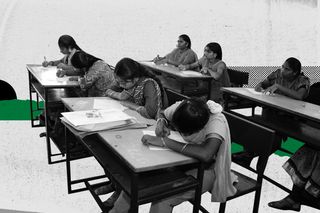
UP’s Two‑Child Policy Overlooks Women’s Access to Education As a Population Control Measure
Coercive measures like Uttar Pradesh’s two-child policy overlook women’s rights and become performative at best.

A recent policy by Uttar Pradesh’s law commission doubled down on the two-children scheme as a population control measure and recommended incentivizing and penalizing measures. If someone doesn’t follow the policy, they will face restrictions in government jobs, availing ration, and other benefits. This has revived the political and socio-cultural implications at play, bringing up two questions: Is India experiencing a population explosion?And more importantly, what is the best way to counter population growth?
Population explosion in itself has been called a myth, with experts noting India’s demographic rate is optimistic and even slated to come down.
Coercive measures like the two-child policy have been critiqued on the following grounds: they are anti-poor (punitive measures such as restrictions on government jobs will impact disadvantaged communities) and target the Muslim communities (where birth control measures are generally frowned upon).
But family planning is at its heart a gendered issue, an aspect that is at risk of being drowned out amid polarizing narratives. Any population control measure impacts women’s reproductive rights, which are inextricably linked to their access to education. This is evident by examining the corollary: women in rural areas, who generally have a lower literacy rate, have a high fertility rate.
Girls who complete higher education have a greater chance of being employed in the workforce, which will indirectly impact fertility rates. This is an intuitive argument: Educated women generally have fewer children than uneducated women.
Population control measures centering on women’s perspectives not only reduce fertility rates but also increase skills and economic productivity. Moreover, education also leads to more awareness among women of precautionary measures.
Studies have also shown participation in social and economic activities creates conditions of emotional and social fulfillment for women outside the family context — promoting smaller family sizes. “Motivational schemes may change the attitudes of a small number of families, however, greater gains could be achieved through an investment in women’s education and employment,” T.N. Srivasdava noted in a study.
Related on The Swaddle:
Female Sterilization in Kerala Is Touted as Empowering Women. It’s Really Just Misogyny in Disguise
All of this is not to say family planning doesn’t work. Contraception uptake has been shown to reduce the fertility rate. But its benefits are not straightforward in a country like India, where the misogyny and patriarchal attitudes push the burden of birth control on women (resulting in a spike in female sterilization), and where polarizing politics threaten to marginalize minority religions.
Moreover, punitive measures to discourage childbirth, like limiting job opportunities and education, can do a lot more harm than good. “Imposing drastic disincentives on those with more than two children clearly targets the most disadvantaged—the poor, the malnourished, the poorly educated, and those at greatest risk of maternal, infant, and child mortality. Denying them schooling benefits, rations, employment opportunities, and more ensures that they remain most disadvantaged,” Shireen Jejeebhoy wrote in iDR. Arguably, the measures — in UP and other states — are being touted as a way to draw voters or being politically motivated (to pander to the ruling party’s right-leaning voter base). In the end, the intent and action play out as a performative measure, instead of actually affecting change.
The central government in 2020 told the Supreme Court in an affidavit that “international experience shows that any coercion to have a certain number of children is counter-productive and leads to demographic distortions.” Moreover, such a law will have an unintended impact on sex-selective and unsafe abortions and further skew the sex ratio.
At the same time, while the question of if education is the best contraceptive sounds tempting, it becomes difficult to ignore the challenges to education. Social stigma and lack of resources restrict access to higher education. However, viewing education as an effective way to influence family planning can encourage more investment and policy around education access.
The most constructive way to tackle population concerns, then, is to incentivize higher education and jobs for women. “Educated women are more physically capable of giving birth than uneducated women; but want fewer children and control birth better,” a 2016 study noted.
Arguably, if women play a dominant role in determining the family size, their upliftment remains at the locus of any population control measure. Shailaja Chandra, former secretary of Ministry of Health & Family Welfare, told The Quint the factors to be looked are “not coercive methods, but the question of when to have a child and early marriages.”
“If the girls are married later and they’re allowed to study, certainly benefits of worker participations and all the things that make a difference to a country will fall into place. Unfortunately, neither policies speaks of those aspects,” she says.
Saumya Kalia is an Associate Editor at The Swaddle. Her journalism and writing explore issues of social justice, digital sub-cultures, media ecosystem, literature, and memory as they cut across socio-cultural periods. You can reach her at @Saumya_Kalia.
Related


Restrictions on Journalists Covering Parliament Debate Threaten Transparency, Media Bodies Say
